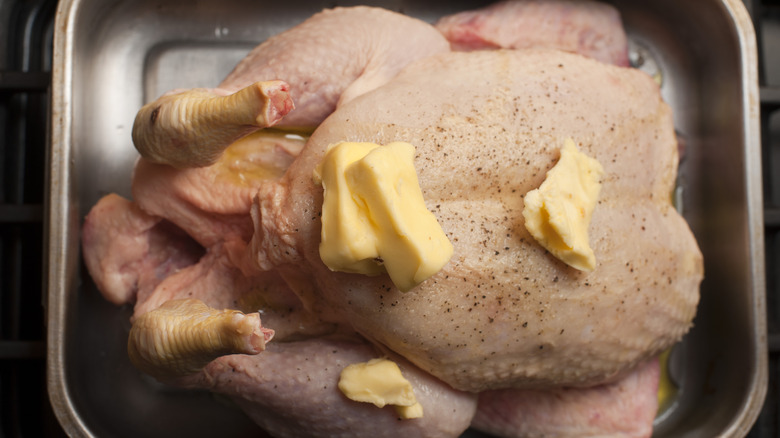The Simple Butter Tip You Need To Cook The Ultimate Rotisserie Chicken
If you haven't dug into a Costco rotisserie chicken while still in the parking lot, where have you been, my friend? These succulent bronzed beauties are at their juiciest when they're still hot. The trouble is that replicating the culinary magic of a Costco chook at home can be a tricky operation. Even after all the faff of setting up a rotisserie in your backyard, producing a chicken that's perfectly juicy on the inside and crispy on the outside can be hit and miss. Luckily, there's a simple tip to help you roast the ultimate chick-rotis that doesn't require a rhyming spell nor a wand; slathering the entirety of the skin with butter before placing it on your spit.
Do this by hand using softened butter (or melt it first and apply with a pastry brush) before skewering your chook onto your metal rod. This baller move with firstly lend your chicken a savory depth and a moreish saltiness after roasting and secondly, create the perfect sticky surface for seasonings, like garlic powder, paprika, and Cajun spices, to cling to. While it's tricky to permeate flavor into the center of a roast chicken, the butter will amplify the umaminess of the skin, creating an almost shell-like crispiness. Feel free to use a homemade compound butter, featuring garlic and fresh herbs, to layer up that savoriness further and elicit an inviting note of aromatic nuttiness.
The milk proteins in the butter trigger the Maillard reaction
The slick of fat applied to the skin of your chicken will trigger the Maillard reaction — the scientific term for when the proteins and natural sugars in foods react together in the heat to create a delicious seared flavor, toasty character, and golden brown surface. While a rotisserie chicken will eventually brown without the addition of extra fat, a layer of butter also speeds up this process because it contains cow's milk proteins. These higher protein molecules catalyze a Maillard reaction in the oven, accelerating the development of a golden brown color and producing a roasted, meaty flavor. Basting the chicken as it rotates on the spit can help to maximize this buttery flavor further.
If you have more time to spare, consider stuffing the butter underneath the skin of your chicken so the breasts stay moist and succulent. Simply lift the edge of the skin and gently ease your hand in the space between the skin and the breast to create a cavity for the butter. Once you've deposited the fat into the pocket, place your hand on top of the skin and smooth it around to distribute it evenly over the bird. This technique will help the butter to stay inside the chicken instead of dripping off into your grill as the chook is turned. You could also try soaking your bird overnight in a wet brine before roasting it on your spit to maximize juiciness.

